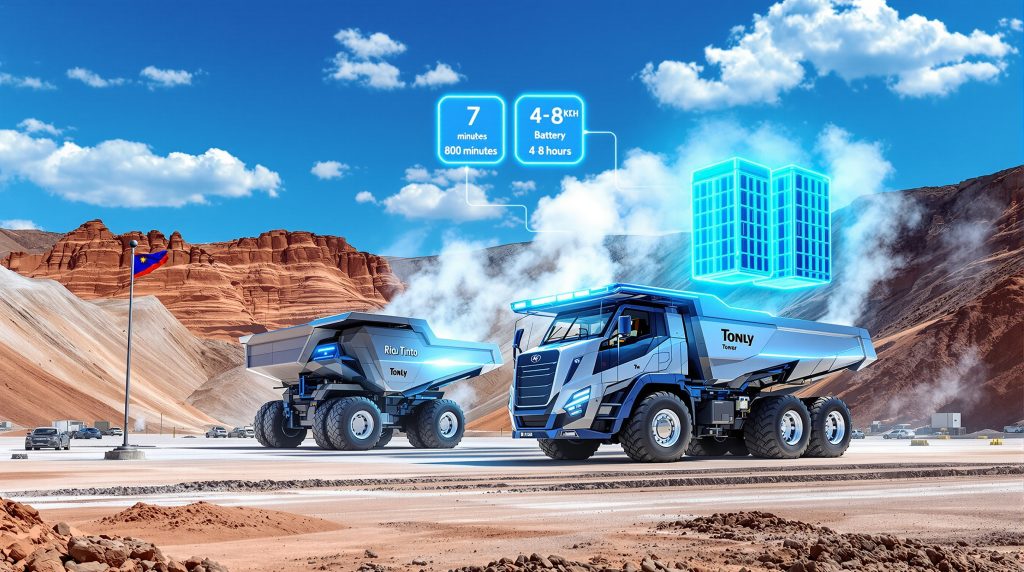What Makes Rio Tinto's Battery Swap Technology Revolutionary for Mining?
Rio Tinto's partnership with China's State Power Investment Corporation (SPIC) Qiyuan represents a pivotal moment in mining electrification. The trial deployment of battery swap technology at the Oyu Tolgoi copper mine in Mongolia introduces a fundamentally different approach to electric vehicles in mining operations in heavy mining applications. The Rio Tinto battery swap truck fleet demonstration showcases how advanced battery technology could revolutionise productivity whilst maintaining operational efficiency.
Understanding Battery Swapping vs. Traditional Charging Systems
Battery swapping technology eliminates the primary operational constraint that has limited electric vehicle adoption in mining: extended downtime during charging cycles. Traditional static charging systems require mining vehicles to remain stationary for 4-8 hours while batteries recharge, creating significant productivity bottlenecks in continuous mining operations.
| Technology Type | Downtime Required | Operational Impact | Infrastructure Needs |
|---|---|---|---|
| Battery Swapping | 7 minutes | Minimal disruption to operations | Robotic swapping station, battery inventory |
| Static Charging | 4-8 hours | Significant productivity loss | Fixed charging infrastructure |
| Diesel (baseline) | 15-20 minutes refueling | Established workflows | Fuel storage and distribution |
The operational mathematics are compelling. Where traditional charging would remove vehicles from service for entire shifts, battery swapping maintains near-continuous productivity levels comparable to diesel operations. This technological leap addresses the fundamental economic barrier that has prevented widespread mining electrification.
Infrastructure requirements for battery swapping systems involve higher initial capital investment but deliver superior operational flexibility. The Oyu Tolgoi installation demonstrates the viability of robotic swapping stations operating in extreme weather conditions, with temperatures ranging from -40°C to +40°C throughout the year.
Technical Specifications of the Oyu Tolgoi Fleet
The trial fleet consists of eight 91-tonne Tonly electric haul trucks, each equipped with 800 kWh battery systems providing approximately 8 hours of operational range under typical mining conditions. This capacity specification positions the vehicles for full-shift operations in auxiliary mining applications, aligned with broader mining industry trends towards electrification.
The supporting infrastructure includes 13 batteries total, enabling continuous rotation whilst maintaining operational capacity. The robotic swapping station represents advanced automation technology proven in Chinese mining operations, adapted for the challenging Mongolian climate conditions at Oyu Tolgoi.
Key Technical Parameters:
- Vehicle payload capacity: 91 tonnes per truck
- Battery energy density: 800 kWh per unit
- Operational range: 8 hours under standard load conditions
- Swapping time: 7 minutes per battery exchange
- Temperature operating range: -40°C to +40°C
Static charging capabilities complement the swapping system, providing backup charging options and supporting maintenance operations. This hybrid approach ensures operational continuity even during swapping station maintenance periods.
How Does Rio Tinto's Partnership with SPIC Qiyuan Drive Innovation?
The strategic alliance between Rio Tinto and China's State Power Investment Corporation leverages China's advanced battery technology expertise and proven mining electrification solutions. SPIC Qiyuan brings extensive experience from Chinese mining operations where battery swapping technology has achieved commercial viability across multiple sites.
Strategic Alliance Framework
China's mining sector has pioneered battery swapping applications in heavy industrial vehicles, with SPIC's subsidiary companies operating hundreds of electric mining trucks across various operations. This proven track record provides Rio Tinto access to mature technology rather than experimental systems.
Technology transfer protocols ensure adaptation of Chinese solutions to international mining standards and regulatory requirements. The partnership structure facilitates knowledge sharing whilst maintaining Rio Tinto's operational control and safety protocols at Oyu Tolgoi.
The collaboration extends beyond equipment supply to include operational training, maintenance protocols, and performance optimisation strategies developed through Chinese mining experience. This comprehensive approach reduces implementation risks and accelerates the learning curve for Rio Tinto's operations teams.
Tonly Truck Integration and Performance Metrics
Tonly trucks represent specialised mining vehicles designed specifically for battery swap operations. The vehicles incorporate reinforced chassis systems to handle repeated battery installations and removals whilst maintaining structural integrity under heavy payload conditions.
Mongolian climate adaptation required significant engineering modifications to standard Chinese specifications. Cold weather performance enhancements include battery thermal management systems, hydraulic system modifications, and enhanced insulation throughout critical components.
Performance Benchmarks Under Evaluation:
- Productivity metrics compared to equivalent diesel vehicles
- Battery life cycles under extreme temperature conditions
- Maintenance requirements and associated costs
- Safety performance during battery swap operations
- Energy efficiency across varying operational loads
Operational testing parameters encompass both normal mining conditions and extreme weather scenarios typical of Mongolia's continental climate. Data collection systems monitor vehicle performance, battery degradation patterns, and infrastructure reliability throughout the trial period.
Why Did Rio Tinto Choose Oyu Tolgoi for This Groundbreaking Trial?
Oyu Tolgoi's selection for Rio Tinto's first battery swap trial reflects strategic risk management principles and optimal testing conditions. The mine's auxiliary operations provide ideal applications for proving battery swap technology without disrupting critical production activities.
Site-Specific Advantages
Non-production applications at Oyu Tolgoi include tailings dam construction and topsoil transportation, representing substantial vehicle utilisation without direct impact on copper production targets. This approach allows comprehensive technology evaluation whilst maintaining operational flexibility.
Risk mitigation through auxiliary operations testing enables Rio Tinto to identify potential issues and optimisation opportunities before considering deployment in primary mining applications. The strategy balances innovation advancement with operational reliability requirements.
Mongolia's extreme climate conditions provide an ideal proving ground for battery technology resilience. Successful operation through -40°C winters and +40°C summers demonstrates technology viability across Rio Tinto's global operations portfolio, which includes similarly challenging environments in Canada, Australia, and other regions.
Strategic Positioning Within Rio Tinto's Global Fleet
Rio Tinto operates approximately 700 haul trucks globally, with around 100 classified as small to medium class vehicles similar to the Oyu Tolgoi trial units. Successful battery swap implementation could potentially affect 15-20% of the company's total haul truck fleet.
Integration with broader electrification initiatives includes Rio Tinto's Pilbara operations in Australia, where the company has invested significantly in renewable energy infrastructure and autonomous vehicle technology. The Oyu Tolgoi trial provides crucial data for potential Pilbara electrification strategies, supporting sustainable mining practices across the company's portfolio.
Scalability assessment encompasses not only technical performance but also economic viability across different mining environments. Factors under evaluation include:
- Infrastructure investment requirements per site
- Operational cost comparisons with diesel alternatives
- Maintenance complexity and spare parts availability
- Training requirements for operations and maintenance staff
- Integration with existing mine planning and scheduling systems
What Are the Environmental and Economic Benefits?
The environmental impact of electrifying mining haul trucks extends significantly beyond direct emissions reductions. Mining haulage operations represent a substantial portion of Scope 1 and 2 emissions across Rio Tinto's global operations, making electrification a critical component of the company's net-zero commitments.
Decarbonisation Impact Analysis
Each electric haul truck replacement can eliminate 200-400 tonnes of CO2 emissions annually, depending on operational hours and local electricity grid carbon intensity.
Emissions reduction calculations must account for the complete energy lifecycle, including electricity generation sources at each mine site. Oyu Tolgoi's grid connection to Mongolia's power system presents different carbon intensity compared to Rio Tinto's Australian operations with higher renewable energy penetration.
Beyond carbon reduction, electric vehicles eliminate local air pollutants including nitrogen oxides, particulate matter, and diesel exhaust emissions. Underground and semi-underground operations particularly benefit from reduced ventilation requirements when diesel vehicles are replaced with electric alternatives.
Environmental benefits extend to noise reduction, with electric drivetrains producing significantly lower operational noise levels compared to diesel engines. This improvement affects both worker conditions and community relations around mining operations.
Operational Efficiency Gains
Electric drivetrains deliver superior torque characteristics compared to diesel engines, potentially improving vehicle performance on steep grades and heavy payload applications. The instant torque availability from electric motors enhances acceleration and hill-climbing capabilities.
| Metric | Electric (Battery Swap) | Diesel Equivalent | Advantage |
|---|---|---|---|
| Operational Availability | 95%+ (minimal downtime) | 90-92% (maintenance, refueling) | 3-5% productivity gain |
| Maintenance Complexity | Lower (fewer moving parts) | Higher (engine, transmission) | Reduced maintenance costs |
| Energy Efficiency | 85-90% motor efficiency | 35-40% engine efficiency | 2x+ energy efficiency |
| Noise Levels | 60-70 dB | 85-95 dB | Significant reduction |
Cost-benefit analysis over the two-year trial period focuses on total cost of ownership rather than simple acquisition costs. Electric vehicles typically require higher initial investment but deliver operational savings through reduced fuel costs, lower maintenance requirements, and improved productivity metrics.
Maintenance advantages include elimination of engine oil changes, reduced brake wear through regenerative braking systems, and simplified drivetrain components. However, battery replacement costs and specialised electrical system maintenance must be factored into long-term economic assessments. Additionally, battery recycling advancements will play an increasingly important role in overall lifecycle costs.
How Does This Technology Compare to Other Mining Electrification Solutions?
The Rio Tinto battery swap truck fleet approach represents one of several electrification strategies being evaluated across the global mining industry. Comparative analysis reveals distinct advantages and limitations compared to alternative technologies.
Industry Benchmarking
Static charging electric mining vehicles have been deployed by companies including Boliden in Sweden, Goldcorp (now Newmont) in Canada, and several operations in South Africa. These implementations demonstrate electric vehicle viability but with significant operational constraints due to charging downtime.
Trolley-assisted electric systems, used extensively in large open-pit copper operations, provide continuous power through overhead electrical systems. However, infrastructure costs and operational flexibility limitations restrict trolley applications to specific mine geometries and operational patterns.
Alternative Electrification Technologies:
- Trolley Systems: Continuous power, high infrastructure costs, limited flexibility
- Static Charging: Proven technology, significant downtime challenges
- Battery Swap: Minimal downtime, higher complexity, emerging technology
- Fuel Cells: Long range potential, limited hydrogen infrastructure
- Hybrid Systems: Balanced approach, moderate efficiency gains
Battery swapping technology occupies a unique position by addressing the primary limitation of static charging whilst maintaining operational flexibility compared to fixed infrastructure solutions like trolley systems.
Technology Maturity and Proven Applications
Chinese mining operations have achieved commercial-scale battery swapping implementation with over 500 electric mining vehicles operating across multiple sites. This operational experience provides crucial performance data and identifies optimisation opportunities for international deployment.
International mining sector electrification trends show accelerating adoption driven by environmental regulations, carbon pricing mechanisms, and corporate sustainability commitments. Major mining companies including BHP, Anglo American, and Glencore have announced significant electrification investments.
Risk assessment for early adoption strategies must balance first-mover advantages with technology maturity concerns. Rio Tinto's approach leverages proven Chinese technology whilst adapting to international operational standards and regulatory requirements.
What Challenges Must Rio Tinto Overcome During the Trial?
The Oyu Tolgoi battery swap trial faces several technical and operational challenges that will determine the technology's broader applicability across Rio Tinto's global operations.
Technical and Operational Hurdles
Battery performance in Mongolia's extreme temperature conditions represents the primary technical challenge. Lithium-ion batteries experience significant capacity reduction at low temperatures, potentially affecting operational range and charging efficiency during winter months.
Infrastructure reliability in remote mining locations requires redundancy and maintenance capabilities that may not exist for conventional mining equipment. The robotic swapping station represents sophisticated technology that demands specialised technical support and spare parts inventory.
Critical Challenge Areas:
- Battery thermal management in extreme weather
- Robotic system reliability and maintenance
- Integration with existing mine operations workflows
- Staff training and technology adoption
- Supply chain for specialised components
- Electrical infrastructure capacity and reliability
Integration with existing mining operations presents workflow challenges as electric vehicles may operate differently than diesel equivalents. Mine planning systems, maintenance schedules, and operational procedures require adaptation to accommodate battery swap logistics.
Economic Viability Assessment
Capital investment requirements for full-scale deployment include not only vehicle acquisition costs but also infrastructure development, training programmes, and operational modifications. The economic analysis must consider these comprehensive implementation costs.
Return on investment calculations depend heavily on diesel fuel price assumptions, electricity costs, carbon pricing mechanisms, and operational efficiency gains. Fluctuations in these variables significantly impact the economic attractiveness of electrification investments.
Long-term cost implications include battery replacement cycles, technology obsolescence risks, and evolving maintenance requirements as the technology matures. These factors introduce uncertainty into financial projections and investment decisions.
When Will Results Determine Broader Fleet Electrification?
The Oyu Tolgoi trial operates on a carefully structured timeline designed to generate comprehensive performance data before broader deployment decisions.
Trial Timeline and Evaluation Metrics
The two-year testing period extends through the end of 2026, encompassing multiple seasonal cycles and varied operational conditions. This timeline allows evaluation of battery performance across Mongolia's complete temperature range and different mining applications.
Key Evaluation Metrics:
- Vehicle productivity compared to diesel equivalents
- Battery degradation rates under operational conditions
- Infrastructure reliability and maintenance requirements
- Operational cost comparisons including energy, maintenance, and labour
- Safety performance and incident rates
- Environmental impact measurements
- Staff satisfaction and adoption rates
Data collection frameworks encompass both quantitative performance metrics and qualitative operational feedback. Advanced telemetry systems monitor vehicle performance, whilst operational staff provide insights into practical implementation challenges and opportunities.
Scaling Potential Across Rio Tinto's Global Operations
Applicability to different mining environments requires careful analysis of climate conditions, electrical infrastructure availability, and operational patterns across Rio Tinto's portfolio. Not all sites will be suitable for immediate battery swap implementation.
Fleet replacement strategies must consider vehicle lifecycle timing, capital allocation priorities, and operational readiness across different geographic regions. The phased approach allows optimisation of deployment sequences based on site-specific factors and strategic priorities.
Investment requirements for company-wide adoption could reach hundreds of millions of dollars when considering vehicle replacement, infrastructure development, and operational modifications across Rio Tinto's global truck fleet.
How Does This Initiative Position Rio Tinto in the Green Mining Revolution?
The Rio Tinto battery swap truck fleet represents strategic positioning within the broader transformation of the global mining industry toward sustainable operations.
Industry Leadership and Competitive Advantage
First-mover benefits in battery swap mining technology could provide Rio Tinto with operational advantages and potential intellectual property positions as the technology matures. Early adoption experience generates valuable knowledge assets for future deployments.
Market positioning relative to mining industry peers becomes increasingly important as environmental regulations tighten and stakeholder expectations evolve. Companies demonstrating concrete progress on decarbonisation may access preferential financing terms and market valuations.
Innovation leadership in sustainable mining practices aligns with Rio Tinto's strategic objectives whilst addressing growing investor and regulatory pressures for environmental performance improvement. The trial demonstrates commitment beyond policy statements to concrete technological implementation.
Future Technology Development Pathways
Potential technology licensing and partnerships could emerge from successful trial outcomes, creating additional revenue streams and strategic alliances. Rio Tinto's operational experience with battery swap technology represents valuable intellectual assets.
Research and development investment implications extend beyond the immediate trial to broader electrification strategies across Rio Tinto's operations. Successful implementation could justify expanded R&D investments in related technologies, supporting wider energy transition insights across the mining sector.
Future Development Opportunities:
- Autonomous electric vehicle integration
- Renewable energy optimisation for charging operations
- Battery recycling and circular economy applications
- Advanced battery chemistry developments
- Integrated mine electrification systems
- Carbon credit generation and trading strategies
Long-term vision encompasses fully autonomous electric mining fleets operating on renewable energy, representing a fundamental transformation of mining operations toward sustainable, high-efficiency systems.
What Does This Mean for the Future of Mining Equipment?
The Oyu Tolgoi battery swap trial signals broader transformation trends affecting the global mining equipment industry and related supply chains.
Industry Transformation Implications
Equipment manufacturers face pressure to accelerate electric vehicle development programmes and adapt manufacturing capabilities for new technology requirements. Traditional diesel engine expertise becomes less relevant as electrification adoption increases.
Supply chain implications extend to battery manufacturers, charging infrastructure providers, and specialised component suppliers who must scale operations to support mining industry demand. New partnerships and supplier relationships will emerge as the industry evolves.
Industry Evolution Drivers:
- Environmental regulations and carbon pricing
- Operational cost advantages of electric systems
- Technology maturation and reliability improvement
- Infrastructure development and standardisation
- Skills development and workforce training
- Financing mechanisms for new technology adoption
The shift toward electrification creates opportunities for technology companies and challenges for traditional equipment manufacturers who must invest significantly in new capabilities whilst managing declining diesel equipment markets.
Investment and Market Opportunities
Equipment financing and leasing models must evolve to accommodate higher initial capital requirements and different operational characteristics of electric mining equipment. New financial products and structures will emerge to support industry transformation.
Technology provider partnerships offer growth opportunities for companies with expertise in batteries, power electronics, charging infrastructure, and related systems. The mining industry represents a significant new market for these technology sectors.
Market growth projections for electric mining equipment suggest substantial expansion over the next decade as technology matures and adoption accelerates. Industry analysts project 20-30% annual growth in electric mining vehicle sales through 2030, driven by regulatory requirements and operational advantages.
Disclaimer: This analysis is based on publicly available information and industry trends. Investment decisions should be made with appropriate professional advice and consideration of individual circumstances. Technology performance projections are subject to operational conditions and technological developments that may affect actual outcomes.
The Rio Tinto battery swap truck fleet trial at Oyu Tolgoi represents more than a technological experiment. It signals a fundamental shift toward sustainable mining operations that could reshape industry practices, supply chains, and competitive dynamics throughout the global resources sector. Success or failure of this initiative will influence electrification strategies across the mining industry for years to come.
Looking to Invest in Mining Innovation Leaders?
Discovery Alert's proprietary Discovery IQ model identifies significant ASX mineral discoveries instantly, helping investors capitalise on breakthrough technologies and operational advances that drive market value. Explore how major mining discoveries have generated substantial historical returns by visiting Discovery Alert's discoveries page and begin your 30-day free trial today to position yourself ahead of the next industry transformation.




